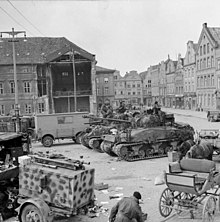Wismar town hall


The town hall of the Hanseatic city of Wismar is a classical building that was built in the years 1817-19 on the old market of the city.
The Barca construction
The Wismar town hall, like other classical town hall buildings in Mecklenburg-Schwerin, goes back to the planning and design of the court architect Johann Georg Barca and was built from 1817 to 1819. The east wing was badly damaged during World War II. After the Second World War , the damage was repaired and the heavy-looking facade was slightly revised and smoothed in line with the system architecture of socialist classicism . In the meantime, for example, the relief bands of the outer gable have been restored and removed as originally. The new building contains older vaults and remains of masonry from the previous house from the second half of the 14th century in the western part.
The large audience hall of the town hall was initially to be painted by the Wismar painter Carl Düberg († 1849), but he could no longer do this. According to Schlie, the hall was then decorated by Michaelsen .

prehistory
The city's oldest town hall burned down in 1351. The process is documented to the extent that all of the city's previously documented privileges were burned. King Magnus of Sweden and Duke Albrecht zu Mecklenburg then confirmed these privileges on the basis of the copies of the documents available to them ( document replacement ). Schlie interpreted the second town hall on the basis of old city views as a presumably two-storey building along the market, "in which the focus of architectural art ... must have been shifted to the gable" The front facade to the market was made of black glazed brick like the Lübeck town hall . The hall on the ground floor of the town hall consisted of twelve cross vaults in double rows. The new Gelag (1458) and the rose (1465) are documented in the cellar . The Wismar Ratsweinkeller was mentioned as early as 1266 with the donation of wine from Duke Heinrich the Pilgrim , which was given to 20 churches in the Ilow region.
literature
- Friedrich Schlie : The art and history monuments of the Grand Duchy of Mecklenburg-Schwerin. Volume II: The district court districts of Wismar, Grevesmühlen, Rehna, Gadebusch and Schwerin. Schwerin 1898, reprint Schwerin 1992, p. 176 ff. ISBN 3910179061
Web links
Individual evidence
- ↑ Possibly the sculptor Ernst Michaelsen (1835–58)?
- ↑ Schlie (1898), p. 12 ff.
- ↑ Schlie (1898), p. 176 ff.
- ↑ Recorded in the Wismar wine register from 1479 (Mecklenburgisches Urkundenbuch 1059, 2622)
Coordinates: 53 ° 53 ′ 30.8 " N , 11 ° 27 ′ 57.6" E


